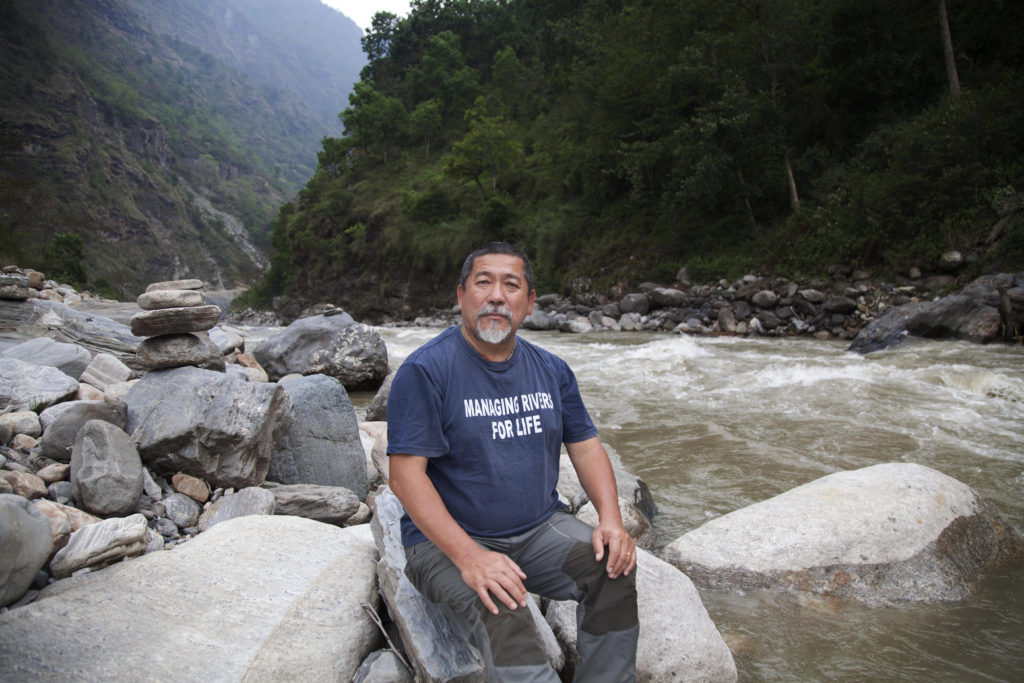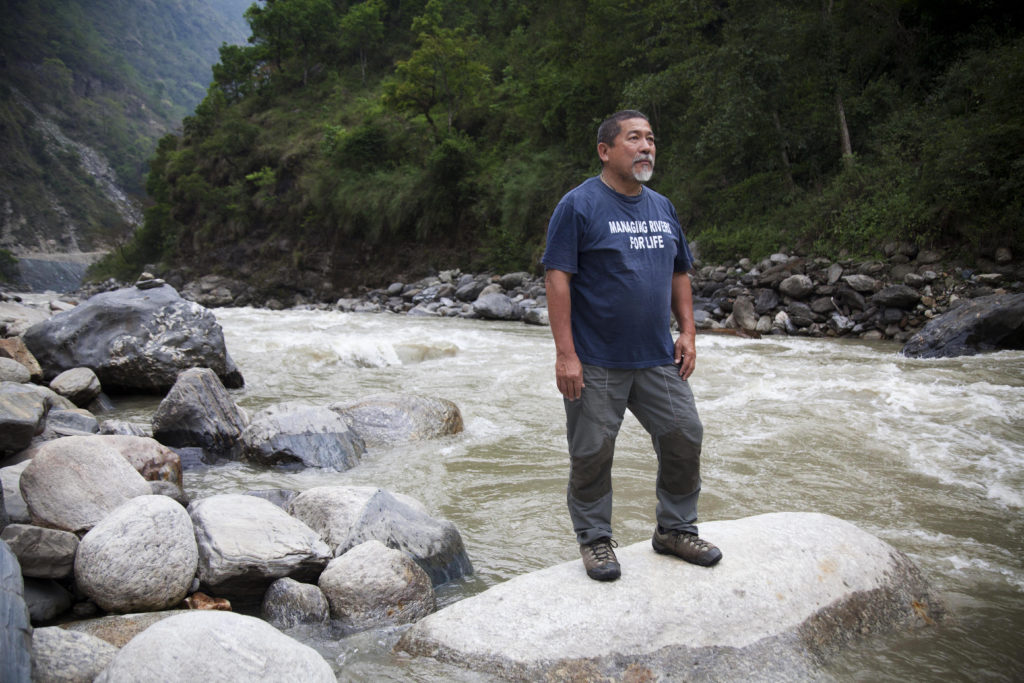A River Runs Through Him | Megh Ale, Karnali River Waterkeeper
By: Gary Wockner
Megh Ale keeps finding ways to protect Nepal’s last wild river.

By Gary Wockner.
Photos by ©Sailendra Kharel, courtesy of Culture Trip.
For as long as he can remember, Megh Ale (pronounced “Ah-lay”) has had a passion for rivers. “As a child in Nepal, I was unhappy in school,” he recalls. (Born left-handed, he was forced to write with his right hand.) “And so I would run to the river to fish, swim, and, often, just for solace.” He is remembered by many of his fellow villagers for helping them cross the river. He also won their admiration for saving several of them from drowning in the river’s strong currents.
Megh is a patient man, and patience is a virtue in Nepal if you are a river conservationist. The corners of his mouth almost always turn up into a soft smile, and his eyes twinkle. But a sense of alarm is also there in Megh’s face and voice. Nepal has about 6,000 rivers and tributaries, and every single river is dammed, except one. That’s right — one. Now, that final free-flowing river, the Karnali, which is Nepal’s longest river and classified as one of the world’s top five rivers to raft, is also threatened by a massive dam project. Megh is leading the fight to save it.
After graduating from college, Megh found his calling, not surprisingly, as a river guide for an outdoor company that conducted Himalayan river expeditions. He did it for six years in Nepal, then, with the experience and skills he developed, worked as a river guide in Austria, Switzerland, Turkey, and the United States.
After returning home in 1991, and founding a whitewater rafting company named Ultimate Descents – Nepal, his passion for rivers blossomed into activism. In 1995 he started the Nepal River Conservation Trust, now the country’s flagship organization for protecting rivers. Life as a Waterkeeper began much later, in 2015, when Megh joined with Waterkeeper Alliance to launch a series of local Waterkeeper organizations in Nepal. Currently, there are 12, representing the Karnali, Bagmati, SetiGandaki, Trishuli, and Sunkoshi Rivers, as well as a countrywide organization, Waterkeepers Nepal. Megh is the Waterkeeper for the Karnali River.
Over the last 25 years, Megh has received wide recognition, as well as numerous awards, for his work. In 2007, Ashoka, a U.S.-based organization that identifies and supports the world’s leading social entrepreneurs, awarded him a fellowship. When he received it, he was described this way:
“Transforming the way people understand the value and economic potential of Nepal’s rivers, Megh Ale is saving the rivers of Nepal through ecotourism, conservation, and cleanup through his organization, the Nepal River Conservation Trust. Megh is creating new opportunities for people in Nepal and all over the world to experience and benefit from Nepal’s rivers and waterways.”
And he is busy doing just that to this day — in particular, on the Karnali River.
The rivers of Nepal are facing an onslaught of dam-building threats, and Megh has worked tirelessly to oppose many of them. His primary weapon is promoting ecotourism and other aspects of the recreational economy as an alternative to river-destroying dam building.
His work involves educating and empowering communities to speak up for their local rivers when the dam builders come knocking. He has allied with dozens of local schools, trained more dozens of raft guides, created festivals and events, including three national river summits since 2014, and — through his adventure-tourism company — taken thousands of people rafting on Nepal’s rivers. “Transforming the way people understand the value and economic potential of Nepal’s rivers represents our best chance of saving them,” he says.
To really get to know Megh and appreciate his passion for rivers requires joining him on a rafting trip on his sacred Karnali.
“Transforming the way people understand the value and economic potential of Nepal’s rivers, Megh Ale is saving the rivers of Nepal through ecotourism, conservation, and cleanup through his organization, the Nepal River Conservation Trust. Megh is creating new opportunities for people in Nepal and all over the world to experience and benefit from Nepal’s rivers and waterways.”
The Karnali, which means “turquoise,” begins in the Himalaya Mountains in Tibet, near Mt. Kailash, the spiritual center for three major eastern religions — Hinduism, Buddhism, and Jainism. The mountain is believed to be where the Hindu Lord Shiva sits in a state of perpetual meditation. In bold contrast, the Karnali is never still. It rages down the canyons of western Nepal, its glacier-fed blue-green waters glistening in the sun.
In the first week of November 2016, which is the dry season in Nepal, I joined Megh and his team from Ultimate Descents as they led 21 international adventurers from 10 different countries on an eight-day trip on the Karnali — the inaugural “Karnali River Waterkeeper Expedition,” dedicated to the river’s protection.
On our first day, five of us awoke early in the village of Tallo Dungeswar and drove 18 miles upstream to the village of Daab. GMR, a private Indian engineering firm, proposes to build a 1,345-foot tall hydroelectric dam there that, if built, would be the world’s tallest. The GMR project, which would generate electricity primarily for export to India, is just one of several proposals to dam the Karnali.
The proposals have ignited a massive controversy in Nepal while drawing international attention from activists and media. Soon after we arrived, Megh mischievously led four of us through the village to the riverbank to unveil a “SAVE THE KARNALI” banner that proclaimed it to be “The last best place in Nepal and only free flowing river in the country.” We photographed the event and returned to our trip’s starting-point, which would be the last large settlement we’d see for eight days. Most of the canyon downstream from Tallo Dungeswar is dotted with small farming villages accessible only on foot.
Leaving our bus behind, we quickly eased into the water. As our “armada” of three large rafts and three kayaks set off, I could see the blade of my paddle through the Karnali’s blue-green water, which is clear to a depth of about six feet, then becomes clouded by the dissolved minerals running off the Himalayan glaciers. It was easy to see why Megh loved this river and this landscape, and has spent a good part of his life trying to save it.

In part due to Megh’s work, the dam proposals for the Karnali have been delayed for two decades. Megh’s countering proposal, obviously, is to keep the Karnali free flowing and a source of conservation, eco-tourism dollars, and national pride. In this quest, he and his colleagues have brought together members of the country’s many religious and ethnic groups, as well as residents of local communities. He is also working to build a countrywide campaign to produce legislation similar to the U.S.’s National Wild and Scenic Rivers Act, to protect the Karnali River and its corridor, which extends through Nepal and into India.
As we continued down the river, we came across villages carved out of the forest every few miles. Their inhabitants have been thriving there for hundreds of years by fishing, farming rice and vegetables, and hiking out of the canyon to sell and trade other goods. The villagers sold us fish and vegetables, and, at one location, a goat, which we slaughtered and ate over the next two days. We also frequently encountered villagers in long dugout canoes, paddling along the edges of the river and ferrying themselves and their products from bank to bank across its calmer stretches. Occasionally, we saw people slipping through the forest above us, sometimes walking down to the beach to say hello.
While the human culture along the Karnali is several hundred years old, the geology of the river and the canyon has been forming for millions of years. And today it is a world-renowned rafting destination. Over an unforgettable two-day stretch, Megh led us through a steep-walled, hard-rock canyon that created fabulous rapids. We raced through “class III” and “class IV” rapids nicknamed “Sweetness and Light,” “Jailhouse Rock,” “God’s House,” “Juicer,” and “Flip and Strip.” Although the proposed dam, tunnel, and powerhouse are upstream of this wild section of the river, the rapids would nonetheless be diminished by the hydropower project. And the wonderful beaches that line the riverbanks would be even more diminished — the dam would trap all of the sand and sediment upriver and, over time, would rob the beaches in the lower river of their sand, just as dams do all over the planet.
The dam also would block the passage of endangered migrating fish, including the mahseer, which can grow five feet long and weigh over 100 pounds, and the giant catfish, which can be even bigger. And it would further endanger the human culture that survives on the fish, as well as the river’s burgeoning ecotourist economy.
Megh foresees a “Karnali River National Park” that would protect not only the river, but also a mile-wide corridor all along its route from Mt. Kailash on the Tibetan border, down into Bardia National Park in Nepal, and through Nepal into India to the headwaters of the Ganges. Although the country has many national parks and spends vast amounts of money to protect them and their wildlife, it has no protected rivers.
Our expedition ended after eight days, and we floated out onto the plains at the town of Chisapani, where the river widens before braiding downstream, and where large diversion structures already suck out water to supply the massive rice farms on the plains. So, though the canyon and rapids of the Karnali are undammed, the river is not untouched. Will it remain undammed? Plans to keep it so are gaining steam through efforts to reach out to international funding agencies, media and political leaders, and to further develop the ecotourism economy of rafting and fishing.
In 2018, Megh and a group of activists and scientists spent 44 days on the river completing the first Karnali River scientific expedition, from its source near Mount Kailash down to the border of India, where the Karnali meets the Ganges. The trip was chronicled by news reporters and filmmakers. And In 2020, he will launch the “Great Karnali Quest: Sacred River Corridor Raft Race,” extending 242 kilometers and linked to a national “Visit Nepal 2020” promotion sponsored by the Nepalese government. He never stops finding ways to promote the natural beauty of the Karnali River.
Megh does this all with a shy smile and a workmanlike attitude, and he doesn’t voluntarily speak of his accomplishments. You have to ask questions to pull his vast store of knowledge about the Karnali out of him. But what he does eagerly share are his future plans, and as you listen, you can see the twinkle in his eyes and find yourself caught up in his indomitable hope and enthusiasm.
Gary Wockner is the Poudre Waterkeeper in Colorado. He is also a scientist, writer, and author of the 2016 book “River Warrior: Fighting to Protect the World’s Rivers.”